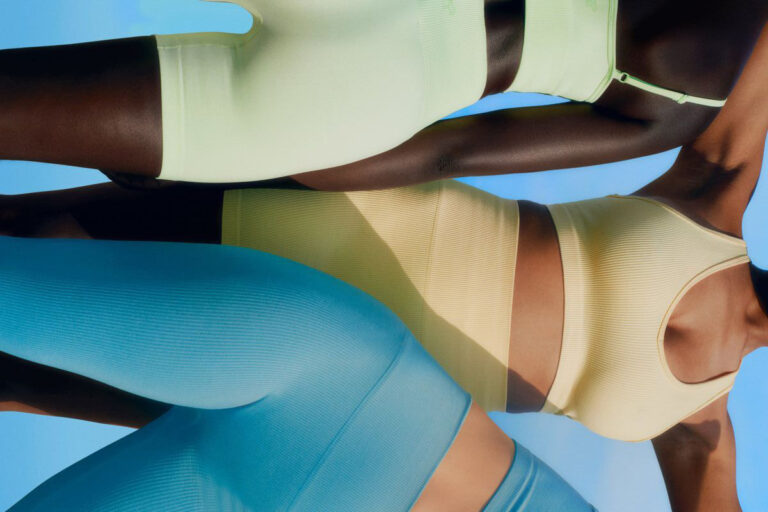How Aritzia’s gen Z push helped it build a cult following
Back when I was about 12, there wasn’t a thing I wouldn’t have done for an Abercrombie & Fitch sweatshirt. Of course, that was all before the brand’s CEO Mike Jeffries came under fire for making comments about people who didn’t ‘fit’ the brand—and before our society uncovered many other unhealthy standards the brand was promoting to easily-influenced kids. It then comes as no surprise that around the same time in my life, just like many other teens, I began hating my thighs and picking at my food.
Fast forward to 2021, and things have changed for the better. More often than not nowadays, mainstream brands that are popular among young customers offer inclusive sizes and diverse model line-ups. In addition to this, gone is the type of monopoly we once witnessed with brands like Abercrombie & Fitch or American Apparel. Given the rise of social media, it’s been harder for such labels to appeal to teenagers who now have hundreds of subcultures to pick from. Even the term ‘basic’ has lost its meaning of late, because trends have been transitioning rapidly ever since we embraced consumerism with our heart and soul.
And yet, among all these brands, trends and products—to cop or not?—we’ve seen the emergence of another company with a loyal customer base that could easily be compared to the ones back from the 2010s. Enter the Canadian women’s fashion brand founded in Vancouver, Aritzia and its cult-like following.
What is Aritzia?
Originally founded by Brian Hill back in 1984, the company only rose to fame after it went public in 2016. Aritzia primarily sells in-house brands, such as TNA (its most popular one), Wilfred, Babaton, Sunday Best, Main Character, Community and more. “We develop our own brands, treating each as an independent label with its own creative team and aesthetic. As a group, they have a few things in common: an effortless appeal, a focus on fit and an of-the-moment point of view,” reads the company’s website.
Its stores also carry clothing from labels such as Citizens of Humanity, Mackage, Six Eleven, New Balance, Levi’s, A Gold E, Havaianas, J Brand Jeans, adidas, Herschel Supply Co. and Rag & Bone. In other words, unlike the past strategies of some mainstream brands, by understanding the needs of the new generation and finding innovative ways of meeting them, Aritzia split its own company into well-curated and different ‘personalities’—its very own labels. Bonus, its signature brands range in demographic as well as price point.
According to Wikipedia, as of January 2021, Aritzia operates 101 stores in North America. Out of these, 68 boutiques are located in Canada including five TNA stores, eight Wilfred stores and four Babaton stores. There are a total of 33 Aritzia stores in the US, including a 13,000 square-foot flagship location in Manhattan, New York City. Its e-commerce website is also highly popular, especially for customers who don’t have an Aritzia store in their country yet—representing a large percentage of the brand’s customer base.
What makes Aritzia so special to gen Z?
We’ll get to Aritzia’s loyal customers soon enough, but before we cover that, it’s crucial we look at the company’s most successful line: TNA. The brand mostly consists of gen Z classics such as tracksuit bottoms, cyclist shorts, hoodies, and puffer jackets—available in all shapes and colours.
On the internet, YouTube videos reviewing the latest TNA drops boast views ranging from 1,000 to 35,000. YouTubers like RachelRachel regularly post Aritzia shopping hauls on their channel in an effort to help potential online customers pick the right fit and size—in addition to amassing some effortless views on their videos.
Meanwhile on Reddit, r/Aritzia is home to just under 10,000 members who regularly discuss the company’s products, including the ones that are worth buying at the moment and which sizes fit a specific body type best.
Aritzia has also made headlines for a well-deserved celebrity hype after its ‘Super Puff’ TNA puffer jacket, which was first released in 2018, was seen on Ariana Grande, Kendall Jenner, Hailey Bieber and Margot Robbie—thereby catapulting the brand into its ‘fashion icon’ status. Oh, and Aritzia has also consistently been a favourite of the Duchess of Sussex Meghan Markle (who has been spotted in several items from the Babaton and Wilfred range).
All in all, Aritzia can pride itself on being a company that promotes gen Z values. 85 per cent of its employee base is made up of women, including 67 per cent of its Aritzia Leadership Team. Three of the brand’s six executive officers and 98 per cent of its retail management team are also female, as president and COO Jennifer Wong told Forbes in May 2021.
“In addition, one of our board committees oversees governance and diversity, which includes consideration for female representation both on our board and in senior management positions. We work hard to create opportunities for young women to join the workforce and gain skills to grow in multiple career paths because championing, supporting, and growing women in leadership and across all levels of our organization is core to our beliefs,” Wong continued.
Although real estate is a priority for Aritzia, the brand’s digital footprint is also a critical part of its strategy. With an engaged Instagram community of over 1.2 million fans and a robust e-commerce infrastructure, the brand has managed to stay ahead of its competition during the COVID-19 pandemic, redirecting this growth to its e-commerce site at the same time.
When asked about the growth of Aritzia’s e-commerce, Wong explained to Forbes: “Upon the closure of our boutiques, we took immediate action to drive e-commerce revenue, adjusting our product, marketing and operational strategies appropriately. Despite the challenges, our beautiful product assortment, best-in-class distribution centre, aspirational website, and response from our loyal clientele led to e-commerce growth in excess of 150% through the end of May 2020.”
Because the company also knows how much gen Zers care about their favourite brands taking part in social activism, after the Black Lives Matter protests of 2020, Aritzia started by investing $1 million to expand and strengthen its diversity and inclusion programme and established an executive diversity and inclusion committee led by Wong.
To date, its actions include donating $100,000 to Black Lives Matter and the National Association for the Advancement of Colored People (NAACP) as well as implementing mandatory training and education on systemic racism, racial inequality and social injustice (courses are required for all current and future members of the team; the education covers conscious and unconscious bias, microaggressions, stereotypes, inclusive language, privilege, effective ally-ship and more).
It’s also important to note that this is only the beginning for the brand—with previous accusations highlighting Aritzia’s racist behaviour towards POC employees. “When we say that ‘real change starts from within’, we believe that we can impact change most by starting with the 4,000 people that are at Aritzia,” Wong told Forbes on the matter.
Aritzia’s focus on getting its product right rather than being marketing-led during expansion has been integral to the company’s success. The retailer has not only managed to woo gen Z consumers, but has impressed investors and analysts as well.
However, while the brand likes to claim it doesn’t take part in fast fashion, but instead conceives, creates, develops and retails fashion brands at a quality which no one can match at its competitive price point, it’s hard to ignore some of its labels’ clearly soon-to-be short-lived trends like its Wilfred ‘Free Divinity Jumpsuit’. I absolutely love it now, but what would I think of it in six months? Not sure.
Aritzia has a full sustainability page on its website which details its sustainability initiatives since 2010. It has already banned fur (not including down or wool), joined the Sustainable Apparel Coalition, conducted a “materiality assessment,” joined the Better Cotton Initiative, partnered with the Better Work programme, became a member of the Textile Exchange, and achieved carbon neutrality. The site notes it’s also taking measures to decrease water usage and adopt more sustainable materials. So far so good, right?
With all that in mind, however, it still may not be constituted as sustainable—in fact, Good On You gave the company a ‘Not Good Enough’ rating in the sustainability department, noting that although the company uses environmentally-friendly materials like Tencel, it doesn’t elaborate on actions to eliminate harmful chemicals, or initiatives to limit fabric waste. And while the brand likes to claim it has achieved “carbon neutrality,” per Good On You, its technique of offsetting emissions is effectively useless. It also makes no efforts to reduce emissions in its supply chains.
Meanwhile, although Aritzia reiterates its message to “minimize animal suffering,” it has no formal policy to do so. And because it doesn’t elaborate on animal products used during the first stage of production, animal welfare is not really addressed during its manufacturing process at all.
Long story short, while Aritzia may be better than most fast fashion companies, it isn’t totally transparent when it comes to its sustainability and ethical practices—and we’ve also noted above how it needs to seriously work on its diversity and inclusion programme.






